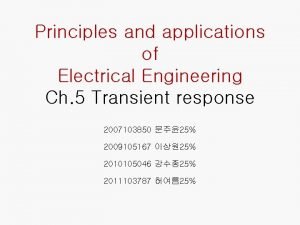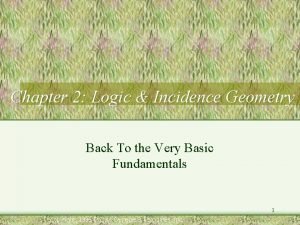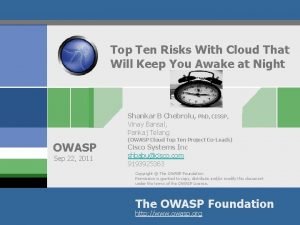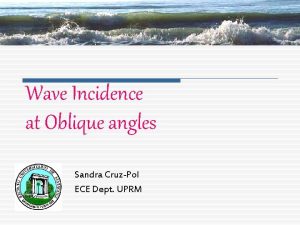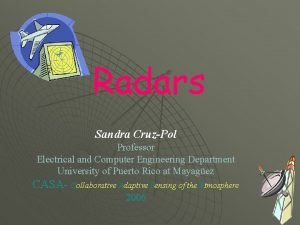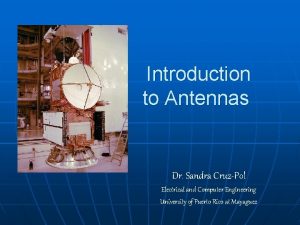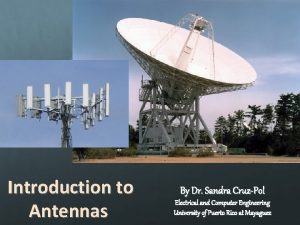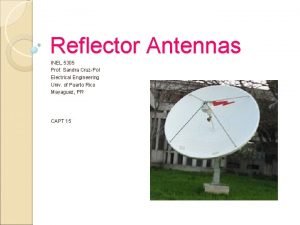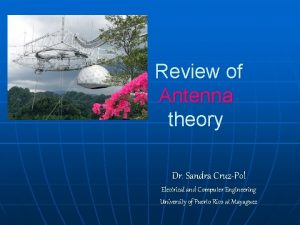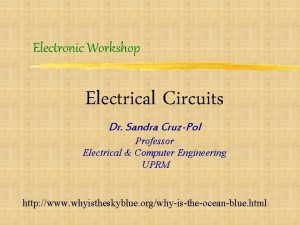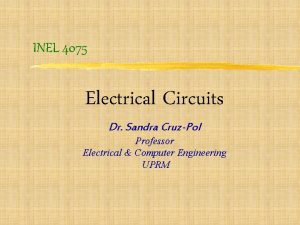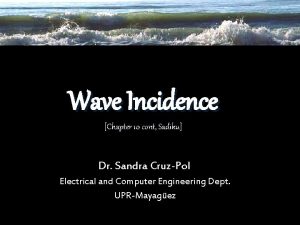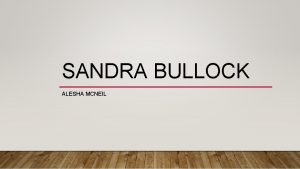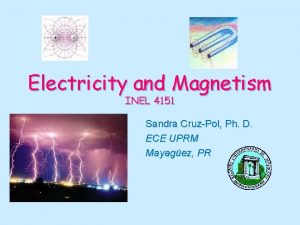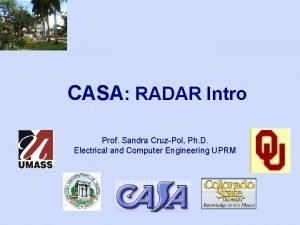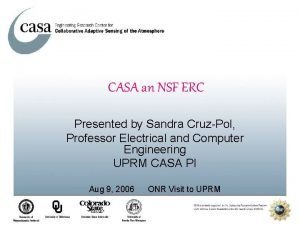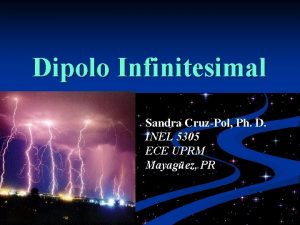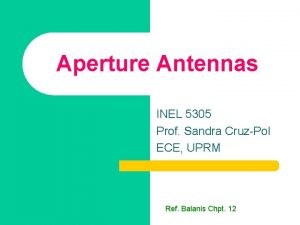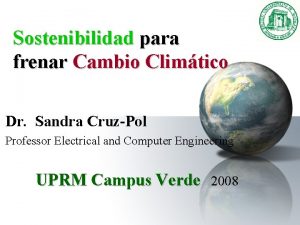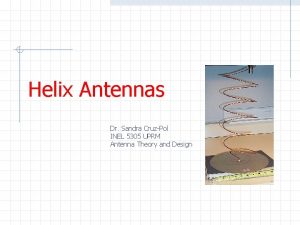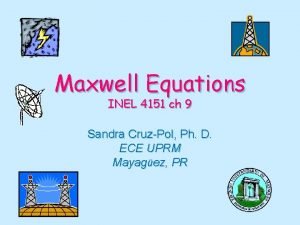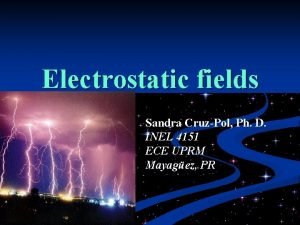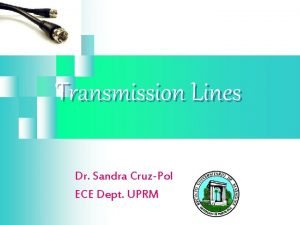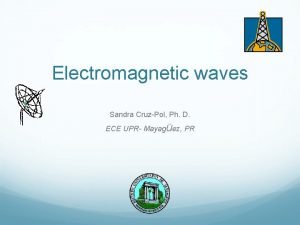Wave Incidence Sandra CruzPol Electrical and Computer Engineering

























- Slides: 25

Wave Incidence Sandra Cruz-Pol Electrical and Computer Engineering Dept. UPR-Mayaguez

Ex. Light traveling in air encounters the water; another medium.

Wave incidence u For many applications, like fiber optics, it’s necessary to know what happens to a wave when it meets a different medium. • How much is transmitted? • How much is reflected back?

We will look at… Normal incidence Wave arrives at 0 o from normal I. • II. Standing waves Oblique incidence Wave • • • arrives at another angle Snell’s Law and Critical angle Parallel or Perpendicular Brewster angle

Reflection at Normal Incidence x Et Ei ak Ht Incident wave Transmitted wave Er z y z=0 akr Hr Reflected wave Medium 1 Medium 2

Now in terms of equations … ¡ Incident wave Ei Hi ak Incident wave

Reflected wave ¡ Er It’s traveling along –z axis akr Hr Reflected wave

Transmitted wave Et Ht ak Transmitted wave

The total fields u u At medium 1 and medium 2 Tangential components must be continuous at the interface

Define u Reflection coefficient, G Note: • 1+ G= t u Transmission coefficient, t • Both are dimensionless and may be complex • 0≤|G|≤ 1

PE 10. 8 A 5 GHz uniform plane wave Eis =10 e-jbz ax in free space is incident normally on a large plane, lossless dielectric slab (z>0) having e = 4 eo and m=mo. Find: Answer: u the reflected wave Ers and -3. 33 ejb 1 z x V/m, u the transmitted wave Ets. 6. 67 e-jb 2 z x V/m where b 2 = 2 b 1 = 200 p/3

Case 1: u Medium 1 = perfect dielectric s 1=0 u Medium 2 = perfect conductor s 2=∞ Halla impedancias int. Refleccion, Transmisión Y campos http: //www. phy. ntnu. edu. tw/java/wave. Superposition/wave. Superpo sition. html

The EM field forms a Standing Wave on medium 1 |E 1 | 2 Eio z Conducting material

Standing Wave Applets u u u http: //www. phy. ntnu. edu. tw/java/wave. Superposi tion/wave. Superposition. html http: //www. ngsir. netfirms. com/englishhtm/Stat. W ave. htm http: //www. physics. smu. edu/~olness/www/03 fall 1320/applet/pipe-waves. html

Case 2: Medium 1 = perfect dielectric s 1=0 u Medium 2 = perfect dielectric s 2=0 u

Standing waves due to reflection Lossless Medium 1 |E 1| Eio (1+|G|) z Lossless Medium 2 At every half-wavelength, everything repeats…

Case 3: Medium 1 = perfect dielectric s 1=0 u Medium 2 = perfect dielectric s 2=0 u

Standing waves due to reflection Lossless Medium 1 |E 1 | Eio (1+|G|) z Eio (1 -|G|) Lossless Medium 2 At every half-wavelength, all em properties repeat

Standing Wave Ratio, s u u or Measures the amount of reflections, the more reflections, the larger the standing wave that is formed. Id s ea The ratio of |E 1|max to |E 1|min = N 1 l o ly ( re fle 0 d. B cti ) on s

PE 10. 9 u u u The plane wave E=50 sin (wt – 5 x) ay V/m in a lossless medium (m=4 mo, e=eo) encounters a lossy medium (m=mo, e=4 eo, s=0. 1 mhos/m) normal to the x-axis at x=0. Find ←Answers: G t =0. 8186 exp(j 171 o) o s =0. 23 exp(j 33. 56 ) Er =10. 03 = 40. 93 sin (wt +5 x + 171 o) y Et = 11. 5 e -6. 02 x sin (wt - 7. 83 x + 33. 6 o) y V/m

Ex. Antenna Radome A 10 GHz aircraft radar uses a narrowbeam scanning antenna mounted on a gimbal behind a dielectric radome. u Even though the radome shape is far from planar, it is approximately planar over the narrow extent of the radar beam. u If the radome material is a lossless dielectric with mr=1 and er=9, choose its thickness d such that the radome appears transparent to the radar beam. u Mechanical integrity requires d to be greater that 2. 3 cm. Antenna with radome Antenna with no radome

Power Flow in Medium 1 u The net average power density flowing in medium 1 Et Ei ak Hi Ht Incident wave Transmitted wave Er y z=0 ak ak H r r Reflected wave Medium 1 Medium 2

Power Flow in Transmitted wave u The net average power density flowing in medium 2 Et Ei ak Hi Ht Incident wave Transmitted wave Er y z=0 ak ak H r r Reflected wave Medium 1 Medium 2

Power in Lossy Media where

We will look at… Normal incidence Wave arrives at 90 o from the surface I. • II. Standing waves Oblique incidence (lossless) Wave • • • arrives at an angle Snell’s Law and Critical angle Parallel or Perpendicular Brewster angle
 How to calculate prevalence
How to calculate prevalence Epirates
Epirates Klipsch school of electrical and computer engineering
Klipsch school of electrical and computer engineering Tum department of electrical and computer engineering
Tum department of electrical and computer engineering System architecture example
System architecture example Difference between full wave and half wave rectifier
Difference between full wave and half wave rectifier Example of longitudinal wave
Example of longitudinal wave Center tapped bridge rectifier
Center tapped bridge rectifier Earthquake p-wave and s-wave travel time graph
Earthquake p-wave and s-wave travel time graph Mechanical waves and electromagnetic waves venn diagram
Mechanical waves and electromagnetic waves venn diagram Example of mechanical wave
Example of mechanical wave Wavelength formula triangle
Wavelength formula triangle Estimating and costing in electrical engineering
Estimating and costing in electrical engineering Principle and application of electrical engineering
Principle and application of electrical engineering Principles and applications of electrical engineering
Principles and applications of electrical engineering Principles and applications of electrical engineering
Principles and applications of electrical engineering How to calculate incidence rate example
How to calculate incidence rate example Incidence geometry proofs
Incidence geometry proofs Owasp cloud incidence analysis and forensic
Owasp cloud incidence analysis and forensic Sound waves are electromagnetic waves true or false
Sound waves are electromagnetic waves true or false What is a semiconductor used for
What is a semiconductor used for Half wave rectifier definition
Half wave rectifier definition Full wave rectified sine wave fourier series
Full wave rectified sine wave fourier series Wave wave repeating
Wave wave repeating The wave chapter 10
The wave chapter 10 Hidden symmetry in fourier series
Hidden symmetry in fourier series













